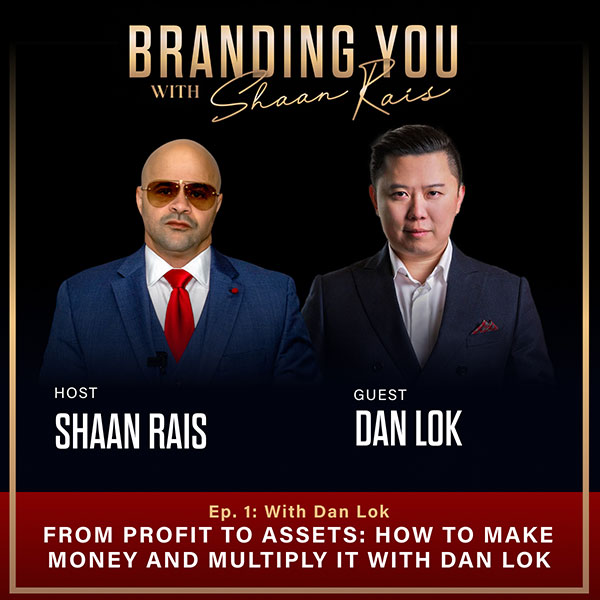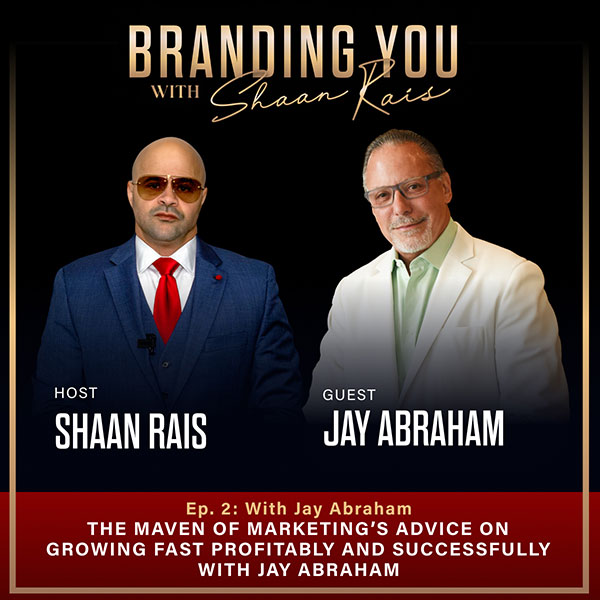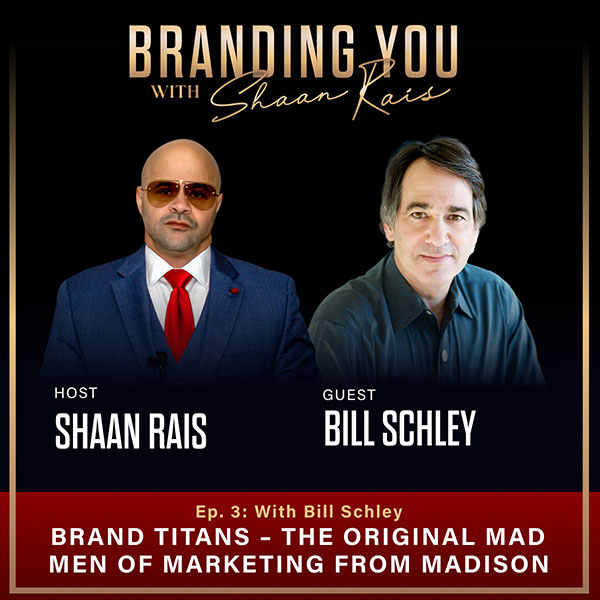Brand Titans – The Original Mad Men Of Marketing From Madison
I am someone who makes the recipe, and I eat my own food. I always talk about coaching, consulting, and how badly it’s needed, as well as how badly it’s needed that you become a student of the game that you’re playing. You have to know your history because if you don’t know your history, you don’t know where you are, and you can’t set a trajectory for where you want to go.
As I am a student and a proponent of branding, it is only right that I bring who I would consider to be the Godfather of Branding. He’s one of the phenomenal leaders of the branding industry all the way back to the ‘60s and before when branding originated. We have Bill Schley with us, who is the Founder of BrandTeamSix and who worked with the original Mad Men of Marketing from Madison Ave before branding was even a thing. Bill, let me take this moment to thank you. Thank you for being worthy, first, for being a student of your own craft, a master of your own craft, and for being humble enough to grace our readers with your presence.
It’s an honor to be on your show. I would bow and genuflect, but I’m already on the floor after that intro. I’m already down. Thank you very much. That’s great. I want to correct one thing. I am not from the ‘60s. The people I worked for, the guys that I followed around and taught us the forgotten secrets of the greatest branders of all times, the people who created more number-one household names than anybody in history. I followed them around. They were from that. I was a little kid cub cop copyrighter, but I got to write it all down and practice it afterward. I want to be clear on that. I’m not 90 years old. I’m a little bit younger than that.
Tell us a little bit about your history with the Mad Men in Madison Ave. What did that look like? What was that like?
The legendary avenue was called Madison Ave. It’s where all the agency sprang up back in the 1930s, 1940s, and 1950s. They were all in that place, but by the time I got there, they were in other parts of town. Some were downtown. We were in Time Square, of all places, at 1515 Broadway, a place called Ted Bates Advertising.
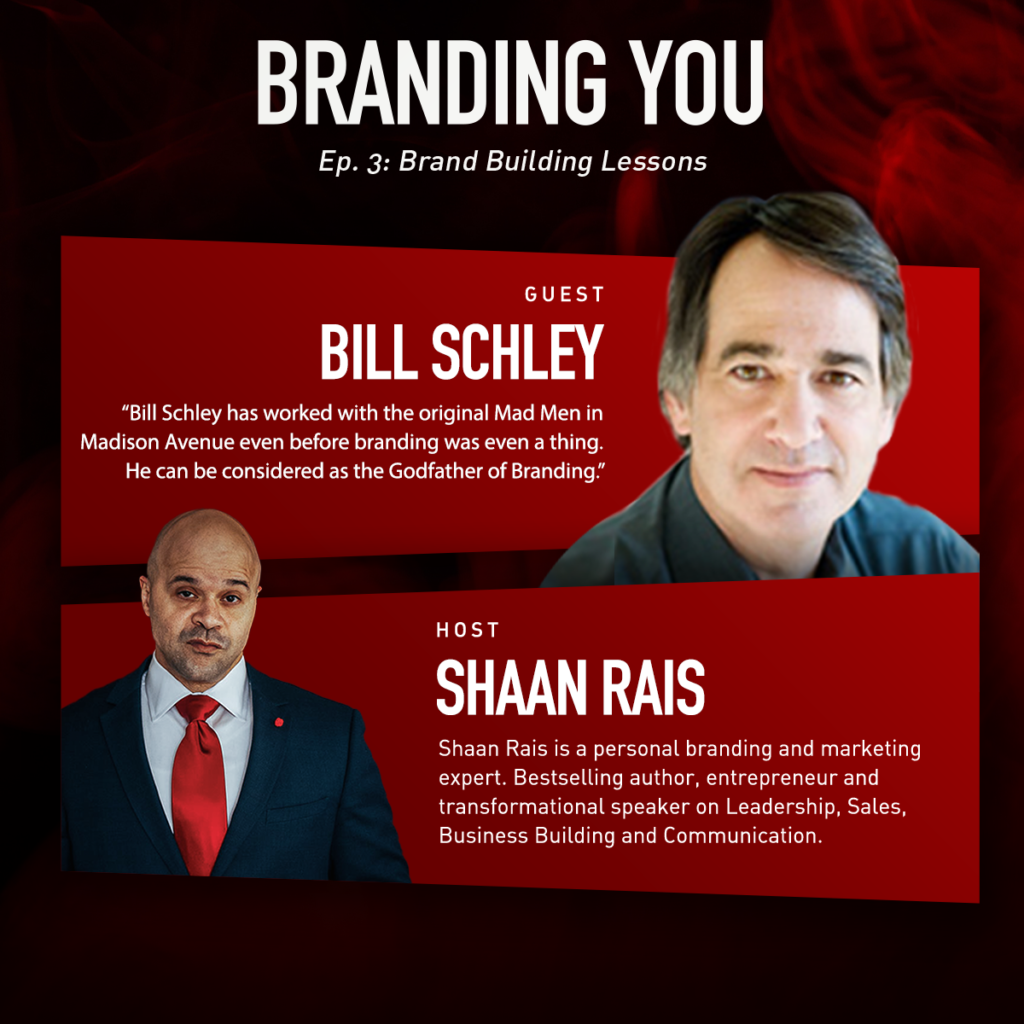
Even though they’re not the most famous like Ogilvy, Bates, in its day, sold more products, and I mean everything from toothpaste to Wonder Bread to M&M’s candies to Prudential, “Get a piece of the rock,” to everything you could imagine. They sold more than all the other agencies combined. They did that because their chairman was this great copywriter named Rosser Reeves. He wrote the book that was our Bible there.
He invented something called the USP, the Unique Selling Proposition, and they drilled that into us at Bates, so we got there. They looked at it scientifically and artistically and said, “How do we get people? How do we penetrate minds? How do we stay there?” They started doing all the famous taglines. People still remember. If I say, “M&M’s melts,” people will finish it. “It melts in your mouth, not in your hand.” That’s from several years ago.
People say, “Wonder Bread builds strong bodies.” They have all the great, long-lasting forever lines in brands. They did cigarettes in those days, but that’s where it came from. They believe that people remember one thing. You can give them 2,000 bits of information, but afterward, if you ask them about what they heard, they’ll tell you one thing. They figured, find that one thing and make that the most important thing in your commercial or your advertisement, and that’s how you penetrate minds.
You think of the great taglines. Prudential, “Get a piece of the rock.” Where that came from was Prudential was the first mutual insurance company, which meant all the insurance customers were also shareholders which is called mutual Insurance, so they said, “Get a piece of the rock.” The rock was the Rock of Gibraltar, but those famous taglines are stuck in your head. That’s all came out of Ted Bates. All from Rosser Reeves. That’s what we learned.
If I didn’t tell you before to get your pens, get your pens. We do things very organically over here, so there’s been no prep, routine, practicing, or scripting behind here because this man is a river that flows with information and knowledge that you need to have. Make sure that you copy it down as much as you possibly can.
When I met Shaan, I said, “This guy’s a branding god. I better be on his show. There’s no preparation for a god’s show.” Anyway, here we are. I know it’s going to be fun. What I would like to tell people what happened is after all that, we got into the digital marketing age. Digital marketing is a revolution and phenomenal. It does all the things that we see it does. It lets things go viral, and you can start a business with nothing and put your ads up on Facebook.
The problem with that was the truth of branding. The way we described it isn’t what they say it is because it’s not about just page views. It’s about a difference that only you can stand for. What I say is technology changes every day, but the truth never does. The truth of branding is that a brand is not logos, color palettes, signage, mood boards, and spirit animals that some people will say it is. All those things come later, but the brand that Shaan and I talk about is a difference attached to your name.
Technology changes every day, but the truth never does.
With that difference, you stand out from every other competitor. It can be the difference between life and death or success and failure for your business. You need that brand if you want to succeed, but it does magical things. It always did, and it still does, but the digital marketers do not give you that. No algorithm can give you that. It comes from your heart, your soul, and the vision of you as a founder. What you want to accomplish becomes your brand, and that’s what we turn into words that we make memorable. That’s the truth.
We make magic.
I’ve seen magic. I’ve seen 3-person companies be sold for 4 years later for $150 million. The difference was they came out with a difference that people decided they wanted this and that. No lie. It can do that.
I have the phenomenal honor and privilege of having one of the original Mad Men of Madison Ave with me talking about branding, branding you, branding your business, and making the idea the difference into one idea that’s a difference attached to your name. We were talking about four men who came together and created a difference that everybody wanted, then turned around and sold their company for $150 million. Can you tell us a little bit more about that, Bill?
I can. I’ve been an entrepreneur my whole life, like Shaan and a lot of people reading. I had left Ted Bates to go off into the world and become an entrepreneur. I did different kinds of things and had some successes and failures like a lot of entrepreneurs do. What happened is, in the late 1999s, Bill Gates of Microsoft made a speech where he said, “The banks are dinosaurs. We’re going to take over with technology.”
The next day, every banker in America went bananas. They decided, “We’ve got to have technology. We’ve got to do this.” They didn’t even know what it was. Remember, they didn’t have cell phones then. The internet was there but it was phone dial-up. It wasn’t anything like it is now but the banks went crazy, “We have to have software.” They didn’t know what it was.
What they decided was, they wanted to give you software that lets you bank at home and do some banking at home. There were two giant programs. Quicken, at that time, was a huge company and also Microsoft Money. These were the two software you could bank at home on your own PC. You could balance your checkbook. It wasn’t even connected yet.
We went into that. These three guys went in, and I came in to help them to this market. They were going to raise money from investors because they wanted to make this easy. The banks wanted it to be easy so the customers would do it because we knew they knew that no one would do anything complicated. Quicken and Microsoft Money had a manual that was 2 inches thick. They knew that 80% of people don’t even balance their checkbook.
Who was going to even use home banking like that? We created the easiest home banking software there was and I helped them do it. I did not do the software but I was going to help them market it because I was a Ted Bates guy. We figured the banks were all going to buy this thing. We went out to try to get it. We couldn’t get one meeting. Not a single at a bank or any place because big banks did not want to do business with five guys in a taxi.
We learned that the hard way. They like to work with other big institutions and big companies. We came back. We couldn’t get a single meeting until we did this one thing. We came up with an idea of a difference and then we turned it into a few short phrases that everybody could remember and repeat, which are the taglines. Here’s what we did. Remember, it had to be the easiest.
We called the software Home ATM. There’s a name that evokes an image, Home ATM. Everybody got that, then we said, “It’s so easy to use. It doesn’t even have a manual.” Remember those 2-inch manuals? That’s how easy we made it to use. We tweaked it so that on the screen, it looked like they were ATM machines.
We said to each Banker, “Now you can have an ATM in every home. If you know how to use an ATM, you’re already an expert in our software.” I call them micro-scripts, little scripts that we can remember. Microsoft and Quicken were saying, “This is easy.” People didn’t even take it out of the shrink wrap. We started to go to conferences and meet some bankers. We said, “We’ve got something called Home ATM.” They immediately looked up.
They immediately said, “What’s that?” They already got an image, then we said, “It’s so easy. It doesn’t even have a manual.” We said, “Do you know how to use an ATM?” “Yes.” “You’re an expert in our software.” The last thing we said was, “Now you can have an ATM in every home.” They said, “When can you come to see us? When can you come to see my boss?” We never didn’t get a meeting again. Now, what’s the power of four sentences on a piece of paper? The cost of one big pen used to be $0.19. I don’t know if you remember. They always leaked in your pocket.
4 lines, 4 micro-scripts, the name, and those tag lines. We grew, and four years later, that company was sold to a New York Stock Exchange company for $170 million. We got a nice bonus for that, but I didn’t become rich from that. I realized from that moment on that I was going to do this as a consultant because every company needed this. That’s when I started my consultancy and my agency. That was about the 2000s when we were built. That’s the story, but it all came from Home ATM if you can see the power of that.
I bet you, everybody on this show is going to remember that. If I asked you a month from now, “Home ATM is like having an ATM in your home,” because that’s the power. One more thing, everybody says a brand is a story, and it is. The power of a story is that you can tell someone a story, and ten years later, they’ll repeat it word for word, but now you need to be able to tell your story in a sentence or less. How’s that one, everybody? That’s what we did in those micro-scripts. We gave it that name. We could tell that story in a couple of sentences, then they could tell their boss. That’s the power. That’s what the Mad Men taught us to do.
Let me give the reader a little bit of a psychological background and you as well, Bill. Let me tell you why I recognized you as soon as I saw your work. We’ve been known for Branding You, Brand You, not what you do, and go from bland to industry-leading brand and go from crickets to digits in the midst of the pandemic.
These are the things that we’re known for helping leaders become brands so they can make their yearly income monthly, their monthly income weekly, and their weekly income daily. These things didn’t stick. As the originator and the creator, you never know what’s going to hit and resonate with your ideal client until you hear them say it back to you. That’s when I began to hone in and lock certain things like, “This sticks.”
I remember one time I wrote a post on Facebook, and I said, “We went from crickets to digits.” A woman said in the background, she commented. She said, “The brother said crickets to digits, I’m dead.” That’s when I knew I had something, so I kept it, and I stuck it. One thing that I read in this book of yours, The Micro-Script Rules, is where you said you tell a story in 2 words or in 1 sentence. It’s not what people hear. It’s what they back to you, what they repeat. Tell us a little bit more about that and the psychology behind that. How does that work?
My first book on branding was called Why Johnny Can’t Brand: Rediscovering the Lost Art of the Big Idea. That was the first book on branding that I wrote. I procrastinated for years because I had a lot of friends in the business. I couldn’t just write a vanity book. They’d all call me up and laugh at me. I wanted to say something, so I procrastinated so much writing that first branding book. I wrote a book on weightlifting instead. It’s a whole funny story. That’s how much I procrastinated, and it became a bestseller, believe it or not. The good thing about that was it taught me how to write a book.
Anything you ever do with passion, energy, and effort, anything that takes a little risk or you are a little scared to do, but you do it anyway. There’s never a wasted moment in your life. You might not know how it’s going to come back and affect your life, but it will. You learn and teach yourself just by getting in motion. That’s getting in different but getting up and moving.

Brand Building: Anything you ever do with passion, energy, and effort takes a little risk, but you do it anyway.
I wrote a book, and it turned out it taught me how to write a book. That was good, but there was a missing piece. The missing piece was when the guys would come up with these great positions for a company. There was one last thing they did, and I didn’t describe it well enough in my first book, even though I wrote about taglines. I realized that those taglines were little micro-scripts. They were little phrases, 1 sentence, and sometimes 2 sentences that people would remember and repeat and tell stories to others using that and realize that’s what they were doing.
They were making these little tiny scripts for you to say and to think, by the way. When people think about your brand, first, they have a need. That’s called a category need. “I cut my foot. I need a Band-Aid,” then they decide which brand to buy. That little voice will tell them that story in their head. That’s how it works. In 2008, I wrote a whole book about that because we’re so critical. The thing about the little micro-script, even though it was about taglines and micro-scripts, was that was important because if you could make your position so sharp, it meant that you had done everything else right. You need to position yourself.
One of the big laws that we have in doing this is the sharper you focus, the narrower you focus, the wider and more penetrating your message will go. That’s another huge branding lesson. You will see so many people and the readers have done it themselves, “I’ve got ten great things. I want to say them all. What if I don’t say feature number eight, and I miss that customer?” You realize when you say ten things, you don’t have one thing.
What happens is when you focus everything on that big idea, and you become the gold medal winner in one thing. People only remember the gold medal winner. They only remember the winner of the Miss America pageant or the golf tournament. They don’t remember anything else, but when you are remembered for that one thing, then they will attribute all those other things to you because now you like, “This company’s the champion of this. That means they must be awfully darn good at a lot of other things. They must be the most popular. They must give good service and have a great product if they can be the top company in this thing.”
That’s the hardest choice you can make in branding because no one wants to choose. That’s why good companies don’t have good brands. They’re afraid to choose. Branding is about sacrificing all those little things once you find that big thing, but it’s a scary thing to do. What I do now and a little plug for my course called the Brand Titans Master Program, the biggest thing is showing you how to choose that one thing because it’s there. We know how to find it. The hardest thing is showing you how to choose and not to be afraid to choose. The test that we use to know that we’ve chosen the best one, so now we can go out with confidence and say, “Gerber baby food. Remember, babies are our business.” They were the specialists, but that’s how it all works.
When I picked this up, that meant it was a pen moment.
There’s a lot of them.
There were a lot of pen moments. Reread this because what you’re learning here is the Bible.
People have to know how simple this is, how common sense this is, and how good their instincts are. People have to know when some of these agencies come in, I’ve been to meetings, and they always have the creative direct addressed all in black with a black turtleneck, a black tie, and a black everything. They’re showing you how complicated branding is. It’s not. It’s a difference attached to your name. Don’t let them fool you, but it’s a very special difference. We talk about that. It’s got five ingredients. This is what we learned at Ted Bates.
We’re going to call you the Godfather of Branding. I had the phenomenal Godfather of Marketing, Jay Abraham, before. I know you’re very familiar with him and I’m sure he’s very familiar with your work as well. We were about to get into the dominant selling idea. What were those five components you’re about to give us?
By the way, I’m honored to be in any place with Jay Abraham as a guest because he is a godfather. If you’re going to make a difference, it’s great. We used to say to people, “What’s the difference?” People say, “I know a difference is,” but you have to know the difference the way the Brand Titans. I call those Mad Men the Brand Titans. They were the ones that created the greatest brands of all time. The way they thought of how a difference worked.
Rosser Reeves, the original guy, invented something in his book, by the way, called the USP, Unique Selling Proposition. A lot of people have heard of that. He was saying there, “Find that one big thing and put all your wood behind that arrow. Make that the spearhead.” You never do a message marketing or branding message without making sure that USP is front and center. You want people to take that away.
The thing with the USP was I wanted to teach this and show this to the people. Also, I wanted to figure out how to make it work myself because I went out in the world to do this. We called it USP. We changed the name a little bit. We called it a dominant selling idea so that I could break it into five parts and tell others about it, but it’s a USP at heart.
What it says is that if you want that big idea, there’s a test. You’ll know you found it. The first ingredient is called superlative. You have to say you’re the best at something. It has to be something that other people aren’t saying necessarily but something you’re the best at. No one ever went out to buy the 2nd, 3rd, or 4th best thing if they could afford it. If you’ve got a need, you want to go to the best.
No one ever wants to buy from the second or third best. If they can afford it, they will always buy from the best one.
In our psychology, everybody loves the number one in anything. Say your brand is number one in something. If someone has other competitors, maybe they’ve been in business for longer, and they stand for the number one thing in the marketplace, you don’t want to go and try to stand for the same number one thing. You adjust a little left to the right and you can find your own category to be number one and it’s done every single day.
That’s one thing that we explain. It’s so much easier than you think, even though it sounds difficult. First of all, that idea has to be something I can say, “We’re the best in this.” It’s superlative. The next thing has to be important to people. My favorite thing is you can say, “We have the biggest selection of brown ties in New York.” That’s great, but nobody wants a brown tie. You find something that’s superlative but something people want.
The next thing is it has to be believable coming from you. That, again, is important. Some of the big corporate brands get very arrogant, and this is happening. Colgate makes toothpaste. The Colgate people say, “Our brand is so great. Anything we sell, people going to snap up because we’re Colgate, after all.” They came out with something called Colgate Bacon. This is true in stores. There’s a reason why no one’s ever heard of Colgate Bacon. How long do you think it lasted?
Most of the time, when I say Colgate Bacon, they get a reaction like you. They go, “Eh,” and so did people because the brand Colgate means toothpaste to people, and they don’t want it to mean that. Again, it has to be believable coming from you. The fourth greeting has to be measurable, meaning I can see it working. Show me proof of performance in some way.
It’s very helpful. Now, people want to buy it and want to believe you. They need intellectual permission to buy. Show me some proof. That’s easy, too. Snickers has more peanuts than any other candy bar. That’s good for you. It was permission to buy a candy bar. The last one, again, is an ownable. If somebody already stands for that difference, then it doesn’t make sense to try to buttheads with them. You’re going to lose.
The best thing to do is create a little bit of a different avenue for yourself. A new category, we call that, and be number one in that. Again, that’s done every day. Those are the five things, something that you can say you are best at, important to people, and it has to be believable coming from you. If Porsche wants to say, “We also sell racing glasses,” maybe that’s believable. It has to be measurable. I can see it working in some way and, finally, ownable. There are tests for that. That’s what it comes out to.
Bill, I do personal branding. That’s my side. That’s my niche in marketing, personal brand, and personal brand leadership. With that being said, I happened to look to the side of you, and I saw people falling in the sky. I see boats and parasails. Tell me a little bit about the person who brands. Tell me a little bit about you behind the scenes. What does that look like? Are you the one jumping out of the planes there?
One of those is me. That’s a thing I had because I’m so bad at certain things. I started skydiving when I was in my 40s because I took golf lessons. The more golf lessons I took in golf, the worse I got. I was so bad at golf, and I’d be so depressed after playing golf anyway. The good thing about jumping out of a plane is it works every time. It goes straight down, guaranteed.
I promise you, you’ll never fall up. Any one of you can try this out. I have always liked planes and flying. You are a little scared, maybe the first couple of times, but it’s amazing what you adapt. The reason why you could go on a plane is because it feels like jumping into a big swimming pool. I’ve done a few of those. For everybody reading, there’s nothing more important than that personal brand. It follows all the same principles. It’s just a little different. I know you’re the expert in this, but I’ll say my view on this.
A lot of people out there throw that out with people. They’re personal brand people all over the place. We’re going to use the same principles of branding a product. You’re going to do the same thing then you’ll be branded like a product. There are so many people teaching that. The problem is they’re not doing it the right way. They’re not doing it the way Shaan does it.
The thing is that it’s all the same principles except there are a few different ingredients there because, on the one hand, because you’re you, you start out unique. There’s only one Shaan raised in the world. There’s only one Bill Schley and only one of you. That’s an advantage. You have a name. People love to remember names, and you see celebrity brands out there all the time.
Sometimes, I’ll see Martha Stewart or Chef Jacques Pépin. They become celebrity brands, and people love to follow them because they gravitate to people and people are unique. You do have that advantage, but the thing is, this is my opinion now. You can learn how to be a celebrity brand so that you start following the same kinds of principles that we teach.
Even for a product brand, you don’t get branded overnight. You pick that difference. You build toward it, you get better, and more people start to see that brand as that special thing. You become famous, but it’s because someone decided at the beginning, “We’re going to make the world’s safest car.” For Volvo, they decided in 1907. They started that company. That guy’s mother-in-law had been killed in a car crash. Guards were deadly then, too. They went 45 miles an hour. You hit a tree, and you’re gone.
He knew that’s what he was going to stand for. It was his personal mission. His vision turned into a brand. That’s what a brand is. The CEO’s vision turned into something tangible and incarnate. It’s the same with your personal brand, but it takes some time because it takes time to either build that proof of what you’ve done or perhaps you have a talent or something you offer that nobody else does but figure out what you want to give to people.
It’s not about you. It’s about them. Your personal brand is going to be about them, not about you. That’s the paradox. The more I give them what they want, the more they’re going to give me what I want. When you understand those things, you’re not going to be a personal brand overnight, necessarily. You might be. Barbra Streisand did one song on Broadway, and she was instantly famous. Maybe that’s you, but for most of us, we first decide on what our position is, our category, or that thing that we’re going to be best at then we build toward it. We build proof, but every step is a step forward from then on.
Your personal brand takes some time to build. After all, it is not about you but about your target market.
Before that, I’m wallowing. I’m going back and forth. It’s spraying and praying. All of a sudden, when you figure out your vision of where you’re going to go, that can become crystal clear. Now, you can put that in the mind of other people. It’s the same thing, but you do it for your personal brand. That’s why Shaan is the King of Personal Branding. That’s what we do. Don’t be fooled by all these people saying, “It sounds good, but it’s fool’s gold. We will make your personal brand.” Not that way. This way.
I love what you say in this book, where you say, “They sell the sizzle but not steak.” That’s what you’re talking about now. One of the things that I like to do is make everything evidence-based. That’s the proof as opposed to the theory. There’s a difference between theory and practice and idea and concrete reality. This is why I bring people like Bill so he can talk about concrete reality because he has the receipts. He has the proof and the evidence. This is someone who I can feel comfortable bringing in front of you because he’s evidence-based. He’s the person.
Tell us a little bit about the more than $1 billion earned because the last book we did was called Billion-Dollar Brand. We’re always talking about building a $1 billion brand because $1 million is not enough. I know you’re very well to do it, the boat shows and the jump. Tell us a little bit about the billion dollars-plus earned while your tenure was taking place.
Do you mean that one specific example of a company? A lot of times, what happens with branding is your revenues and sales can go up but it’s like owning a stock. When the value of your enterprise goes up and you have an acquisition that someone purchases, that’s when most entrepreneurs make big money. It’s when you have something equity that you can sell. That’s how real estate people make big money. It’s a law of big numbers.
We’ve talked about Home ATMs. That’s because there’s a big company that wants to pay them this big valuation, and that’s when the real money gets made so many times. It works for small companies. I’ve done this at big global companies. One reason this is important is because a lot of people say, “I’m too small. This is for big companies with people with big agencies. People hire people like me and pay them all kinds of money.”
The opposite is true. It’s easier for a small company with a vision. If you’ve got a vision that’s crystal clear, you’ve got an asset that no one else has, and that’s free. It’s your vision. Your job is to get that crystal clear vision of other people’s heads. It gets into their heads, directly proportional to how crystal clear you can make it.

Brand Building: If you have a crystal clear vision or an asset that no one else has, it is your job to get them into other people’s heads directly proportional to how you make them.
Small companies don’t have layers and layers of management, middle managers, and people coming in telling you why it’s not a good idea. Committees report to 17 places in the company, and now you’ve got to get this pass by 30 people. All of them can say no. None of them will say yes to get all the way up to the leadership committee where someone up there with a political agenda is going kill your great idea.
You don’t have that problem. That’s what big companies have. That’s why so many of them end up with the stupidest branding in the world like, “Non-branding: a passion for excellence. A difference you can count on.” That’s what they end up with because it’s mush. You can come up with, “It’s made from sugar, so it tastes like sugar.”
The on-time plumber is one of my favorites. Anyway, the billion example. That was a very big company called Rackspace. You don’t always get a chance to do this that many times in your career as a consultant, but I did. I worked for the guy who own the company who read one of my books. That’s how it all started. He happened to love branding, too. What happened there was they were at the top. Rackspace was the number one independent data center company in the world.
They rented space for computers. Instead of having to have a computer in your office, you could rent servers that were kept in a big data center. This is before the cloud. It was all data centers. You bought servers, and they ran it. They made sure it was up all the time and they had all the engineers. It was a very smart way.
You purchase computing power from a data center company like Rackspace. They were the biggest independent one that was not owned by Microsoft or IBM. What happened was their stock was flying high, and the cloud came along courtesy of Amazon. All of a sudden, Wall Street decided that the data center model was dead because you couldn’t compete with the cloud.
All the cloud does is the same thing. The cloud was 1 million servers like Rackspace, but they were now all connected with software. The reason Amazon invented it back in 2002 or 2003 was so that they could buy cheaper computers to run their store. They used to have the store, and the website wouldn’t go down. They had very expensive, super high-quality computers that were very expensive so that they didn’t fail.
Amazon wanted to figure out how you can run on cheap computers. They figured out with this software if they connect to them all a certain way. If one failed, they didn’t even care because the other ones took over. Amazon’s Cloud was 100 times bigger, and the stock went down to almost around $10 to $15 from $80. It was a real big crisis, and we were there. We realized we had to rebrand them. We had to apply the great principles of the Brand Titans. Nobody in their global marketing department knew how to do this. They knew how to manage brands. They didn’t know how to do what we were going to do, which was create the way the Brand Titans has.
Add two new things together and create a new category. Here’s what we did, and this is a well-documented thing. First of all, we said that Amazon Cloud was great, but there’s a little problem with it for a lot of companies. They didn’t give you any customer support. They gave you hundreds of these services. It’s like dumping a pile of parts in your driveway, and they say, “Here, build a Buick out of that.”
That’s great and it was cheap as can be, cents on the dollar. Not all companies are able to do that because they don’t have big IT departments or they’re not in software and technology. They need someone else to help them. They want to get on the cloud because it’s so cheap. It’s a way to scale, but it’s hard getting on the cloud, and things break.
We said, “There are two categories of cloud. There’s the Amazon Cloud.” They said, “That’s the commodity cloud. That’s the one for everybody. It’s a great revolution.” We said, “There’s another cloud. It’s called the managed cloud.” “Really? Another category?” The managed cloud is the cloud that comes with the experts to run it. See that one sentence?
Now we said, “All it means is one’s not better than the other.” They said, “We don’t compete with Amazon. We’re in a different business, a different category. When you need food, you can go to a supermarket. You get all the food in the world. You can construct your dinner. Sometimes, you need a restaurant because you’re traveling or you want to go out for whatever reason. You want to make a super chocolate souffle. You can learn to do it and buy the ingredients in the supermarket. You maybe you want to go where there’s a chef who’s done that 1,000 times.”
One’s a supermarket, and one’s like a restaurant. They’re not the same business. They’re different. You choose if you want to use a commodity cloud, a public cloud, or a managed cloud. That’s two words. We create a new category. We could say, “The number one managed cloud company.” There we were. Now, that was a $6 billion global company, and in two words, they pivoted. This is how dramatic this is. First, I ran that company and then someone wanted to acquire them. The stock went up. It almost tripled and said, “Those two words were worth about $1 billion to us.” That’s a real story.
That’s the power of branding.
The thing is, again, I’m going to say in any career, you don’t get many of those. It was a perfect example. It’s one of those ones that was a real golden example of what we do. We were able to do it in a big company and point to it very specifically because one day, the tagline changed and I know where it came from.
That’s what I’m talking about. Two words can change your life.
Two words can change the world.
Bill, this is our last segment. What question do you need to answer that you haven’t heard me ask yet? I always ask that question. What question am I not evolved enough at the moment to ask you that our readers need to know? What is that impartible wisdom that you want to give them free and clear?
When I was getting into this, we started realizing it. It was something I called the universal theory of everything. Everything I did was talk about branding. I even met Navy SEALs and people like that when I was doing my entrepreneur book. I went to Israel, and we met people who were some of the bravest operators in the world.
The truth of things always came around to the same thing, even branding. It was always about getting to the essence. It was all about getting to the center in anything that you do. I realized that if you want to learn anything fast and anything that’s important, if you can get 2 or 3 rules that are the essence at the center, then you can teach yourself to do it. The best things you ever learn in life are the things that you teach yourself to do.
Other people’s advice is hugely important, but you learn 3 or 4 key principles. You have to learn that from somebody on the outside, then you start to practice. As you practice, that’s when you get the wisdom and the proficiency. You get good at something. Everything I was learning always came around to the same thing, that center. Branding is the most important thing. It’s all about finding the center.
What is that thing at the heart of your business? That vision that you have, the thing that you want to solve for, and the thing that you’re going to do in a little bit of a different way this faster, better, or more economical than anybody else. There’s something in there you wouldn’t have gotten in business, something you believe. Find that thing and turn it as crystal clear. That’s finding the center. That’s the key.
That’s all we’re doing here. Everything in your life is going to be like this. We amaze ourselves. It always comes back to the same set of principles. I’ve got a few rules called 3 or 4, no less, no more. What I mean is there are always 3 or 4 crystal key things. I can teach you to do almost anything if you learn 3 or 4 fundamentals.
What we teach is the fundamentals of branding. The best people on the planet at anything have simply mastered the fundamentals better than anybody else. Bobby Orr was the greatest hockey player in my generation. He was the greatest skater. When you get down, you’re trying to solve problems. When it gets too complicated, it’s not the answer because the real answer is never complicated. If it’s too complicated, you haven’t figured it out yet. That’s how we teach branding. These few key fundamentals mean everything.
The best people on the planet have simply mastered the fundamentals better than anybody else.
I’ll tell you, somebody said, for example, “The greatest tennis player in the world pauses in the match, and his world-famous coach comes up and is whispering into his ear about some secret thing.” People are like, “The world’s greatest coach stated the world’s greatest player that made him pick up and start to win again.” Do you know what the coach says to him? “Keep your eye on the ball.” He said, “Bend your knees.” I’m not kidding. The fundamentals of branding are about the dominant selling idea that people only remember one thing and these five things.
You can find that if you know what to look for and follow that because all is simple. The simple is the most important thing you can ever do, but it’s not easy, or else everybody would do it. What our rules and principles do is make it as simple as possible to find that and crystallize that vision into a few words and pictures that have become your brand. It’s all about the questions you ask at the beginning, not the answers. Those questions are very simple ones, but you have to ask them over and over.
Many salient points. We say clarify, simplify, and amplify because you can’t clarify what’s not clear to you. Once you clarify, you can simplify it. As you said, you can boil it down to those 1 or 2 words of those 4 sentences, then you can amplify the wazoo out of those 4 sentences and turn around.
You have to launch. The thing is, what’s so brilliant about clarifying is it magically does simplify because the clearer you make it, you realize how you get to the center. You start to see how fundamental and basic it is. It will astonish you as you go through it. The point is to get into the law of motion. Get moving. You’re never going to get anywhere if you still hide behind a rock. When you start moving, it’s a little bit scary, but now you start to see the landscape around you.
You start to see visions and perspectives. You didn’t see when you were behind that rock, and you keep going. The law of motion is the biggest thing, and you have to get started. Go toward this thing. You’re going to make mistakes because we all fail our way to success. We know that. That’s not a cliché, everybody. That’s true stuff. You have to be willing to keep swinging.
You will never get anywhere if you hide behind a rock. You have to start moving to see different landscapes, visions, and perspectives around you.
In the first chapter of The 7 Prerequisites to Success, which is my first book, you’re going to have hard times. The second one is to fail because you’re going to fail. It’s inevitable.
It’s the only teacher.
Tell us one of your failures, Bill.
This is one of those great things I like in the interview, you say, “I work too hard every day. I’m sorry. I should have more, but I just worked right now.” There were things that I thought I wanted to do growing up, but I don’t know if they were failures. There are so many of them. You don’t bat 1,000 when you’re doing anything, including branding.
It’s a funny one. I’ve gotten in trouble in my life for my sense of humor. You have to be careful with that. Not everybody has the same failures. Honestly, there were a couple of early businesses that I tried when I left Ted Bates, and I wanted to be an entrepreneur. I left Ted Bates because, as an entrepreneur, I didn’t know if people were going to promote me to where I wanted to be.
I wanted to be in control. I didn’t want other people above me telling me if I was going to rise or fall. I left and went on my own. I did try different businesses. We did all right, but they never got to this wild success that I wanted. One day, after several years, I was moaning about the fact that I wasn’t getting anywhere in the world. I looked at all my friends, and they all looked like they were more successful than me.
I woke up one day, and I said, “You’ve gotten somewhere. You have to realize that you’re a marketer, a strategist, and a brander. Everything you’ve done and what you learned back then, your original passion, you don’t realize, but you’ve gotten better at that without even knowing it.” I said, “I am an expert. All this failure helped me get there.” I don’t have time to go into it now, but I will tell you some of the adventures that I had with the businesses we started because I kept going, all taught me one day what I was. I’ve certainly had plenty along the way, but we kept going.
Through all of that, you came back to the center. That’s what I heard.
I did. It’s a funny thing. That first impulse was to go on advertising. It was the right thing. That’s who I was. I was right back then. I was right about that first impulse.
There’s a saying that comes from my old days in Harlem, New York, growing up, “If you think long, you think wrong.” That’s so powerful to me, the origin brand story, being the right thought and coming back to the center. You left where you started from and then you had to come back to start.
I had to go out in the world to figure out. Remember the Wizard of Oz? Before the wizard takes off, she says, “I always wanted to see what’s over the rainbow, and I finally realized that the secret of my heart’s desire was right there in my own backyard.” That was what Dorothy said. That’s the wisdom and then she clicked her heels, and away she went.
You had to come back to who you are. What we’re trying to say is that your Education, Experience, and Expertise, the three E’s, will turn into the three I’s if you allow it. The Education, Experience, and Expertise will lead you to the Impact, Income, and Independence that you deserve. It’s been such a phenomenal time. I know the time has eluded us and escaped us. Maybe we’ll have you back because this has been such a fundament volume.

That’s what I want my readers to take away from this, the value and the volume. Honestly, me and Bill could do this all day because he’s batting 1,000 at this one thing. While you read, I want you, and Bill just told you to look at your one thing. What is that one thing? Sometimes, it’s so easy to notice that you missed it.
What I finally did after being a one-on-one brander for so many years was a consultant. I could only do a few companies at a time. My mission became to bring this out to hundreds and thousands of people who couldn’t find it anywhere else anymore that need it. The branding stuff that we teach can make you successful.
We started something called the Brand Titans. It’s a program. It’s a master course, but it’s expanded. You can find it at BrandTitans.com. See about what we do, but that’s what we do now. We’re able to give it out to scores of people and watch them grow their brands or their businesses. That’s the plug for all the people out there who may be reading. Thanks, Shaan, for this opportunity.
BrandTitans.com is where everybody can get in contact with you.
They can get in contact and see the basics of what we do in the program. We do it for CEOs, business owners, and decision-makers because when you run something, you’ve got to be able to make a decision about, “We’ve got to change our course a little bit to the left or the right.” Only the CEOs, owners, or business owners are usually the ones or the decision makers that can make a decision because it’s profound. You’ll see something you might not have seen before. You have to have the power to be able to make some adjustments.
That’s the course. Are you still doing consulting one-on-one?
I do, but I’m putting most of my energies into the Brand Titans program because, again, that’s where we’re able to get out to the most number of people at a price that people could afford.
It’s been a phenomenal honor to have you here. Folks, take this advice, take action, and check out BrandTitans.com. I’m a student when it comes to the best of the best. I eat my own food. This is what I tell you to do. I can vouch for it. It’s evidence-based and will be phenomenal. It will continue to do phenomenal numbers, Bill. Thank you so much for being with us and for being a phenomenal guest.
It’s been my pleasure and to be continued, Shaan. Thank you.
Let’s grow.
IMPORTANT LINKS
- BrandTeamSix
- The Micro-Script Rules
- Why Johnny Can’t Brand: Rediscovering the Lost Art of the Big Idea
- Brand Titans Master Program
- Jay Abraham – Past Episode
- Billion-Dollar Brand
- The 7 Prerequisites to Success
- BrandTitans.com
ABOUT BILL SCHLEY
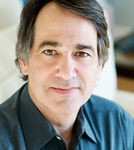
His clients have generated over $1 Billion in new Brand value with this proven formula.
Bill Schley is a New York Times Best-Selling Author and Award-Winning Brand Specialist. He has spent his life perfecting the branding formula any business can use to stand-out from everyone else in their market whatever their category.
His award-winning books include “The Micro-Script Rules” and “Why Johnny Can’t Brand”, both of which are considered marketing classics, taught by experts around the world.
ABOUT BRAND TITANS
Brand Titans offers elite Branding programs for CEOs and Entrepreneurs to create their Ultimate, Differentiated Brand.
Founded by NY Times Bestselling Author and award-winning Brander Bill Schley, The Brand Titans reveal the Lost Secrets and the actual formula of the world’s greatest Branders–the real Mad Men and Women who created the most #1 Brands in history. The key is to find the Difference only you can stand for–then tell it in a story only you can tell via “Micro-Scripts” that every customer can remember and repeat. It’s the blueprint for every communication and your ultimate business strategy– because it makes you the #1 Choice of customers every day.
